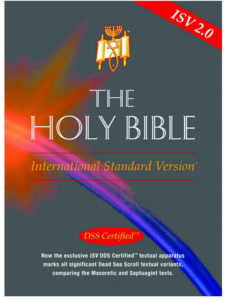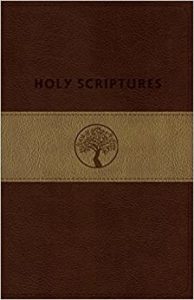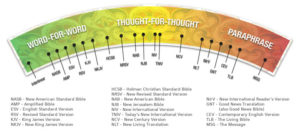Aug
23
What I Want In A Side-by-Side, Parallel Bible, part 2
Last week, I briefly discussed what I thought were shortcomings of the currently-available choices for side-by-side (aka “parallel”) Bibles. I then introduced two hypothetical combinations of four translations each that appealed to me, and which I would like to see in hard-copy editions. I cited Matt. 6:9-13 (i.e., the Lord’s Prayer, aka “Our Father”) as a sample text for comparison. As promised, I have a couple more such combos to suggest this week, beginning with the…

LEB/EHV/ISV/GNT: The Lexham English Bible is a great, formal translation — even moreso than the NASB — produced by Logos Bible Software. Unfortunately, it is currently only available in online formats and not hard-copy. The recently completed Evangelical Heritage Version is a “balanced translation” — which I take to mean somewhere in the “mediating” realm of the spectrum, though perhaps closer to the formal end — from the conservative Lutherans at the Wartburg Project Inc. The International Standard Version is another that I like that takes a “mediating” approach to translation (close to the NIV & NET). It has a particular affinity for Dead See Scrolls variants. The Good News Translation (aka Today’s English Version (TEV)) is an older, dynamic translation from the American Bible Society that used to be quite popular many years ago. (The CEB mentioned in part 1 would be an acceptable alternative for the GNT here.)
LEB –
9 Therefore you pray in this way: “Our Father who is in heaven, may your name be treated as holy.
10 May your kingdom come, may your will be done on earth as it is in heaven.
11 Give us today our daily bread,
12 and forgive us our debts, as we also have forgiven our debtors.
13 And do not bring us into temptation, but deliver us from the evil one.
EHV –
9 Therefore pray like this: ‘Our Father in heaven, hallowed be your name.
10 Your kingdom come. Your will be done on earth as it is in heaven.
11 Give us today our daily bread.
12 Forgive us our debts, as we also forgive our debtors.
13 Lead us not into temptation, but deliver us from evil.’
ISV –
9 Therefore, this is how you should pray: ‘Our Father in heaven, may your name be kept holy.
10 May your kingdom come. May your will be done, on earth as it is in heaven.
11 Give us today our daily bread,
12 and forgive us our sins, as we have forgiven those who have sinned against us.
13 And never bring us into temptation, but deliver us from the evil one.’
GNT –
9 This, then, is how you should pray: ‘Our Father in heaven: May your holy name be honored;
10 may your Kingdom come; may your will be done on earth as it is in heaven.
11 Give us today the food we need.
12 Forgive us the wrongs we have done, as we forgive the wrongs that others have done to us.
13 Do not bring us to hard testing, but keep us safe from the Evil One.’
Since there are a few Messianic Jewish translations out these days, I thought it would be nice to have a few of them in a parallel Bible, too.

OJB/Scrip/TLV/CJB: The Orthodox Jewish Bible seems to be a fairly formal translation that “applies Yiddish and Hasidic cultural expressions to the Messianic Bible.” (Awkward to try to read/study by itself for someone unfamiliar with Hebrew and/or Yiddish/Hasidic terms, which is why I’ve never picked one up.) The Scriptures is a formal translation that, among other things, retains the Tetragrammaton ( יהוה ) for the name of God throughout the Tanakh (i.e., Old Testament). The Tree of Life Version is somewhere between the CSB and ISV in formality/functionality mix while incorporating select Hebrew words — anglicized, of course — listed in a small glossary. The Complete Jewish Bible, translated by David H. Stern, is a rather dynamic translation. In fact, “The Old Testament translation is a paraphrase of the public domain 1917 Jewish Publication Society version. The New Testament section is Dr. Stern’s original translation from the ancient Greek.”
OJB –
9 Therefore, when you offer tefillos, daven like this, in this manner: Avinu shbaShomayim (Our Father in heaven), yitkadash shmecha (hallowed be your Name).
10 Tavo malchutechah (Thy Kingdom come) Ye’aseh rtzonechah (Thy will be done) kmoh vaShomayim ken baaretz (on earth as it is in heaven).
11 Es lechem chukeinu ten lanu hayom (Give us today our daily bread),
12 u-slach lanu es chovoteinu kaasher salachnu (and forgive us our debts as we forgive) gam anachnu lachayaveinu (also our debtors).
13 V’al tvi’einu lidey nisayon (And lead us not into temptation [Mt 26:41]) ki im chaltzeinu min harah (but deliver us from evil). [Ki l’chah hamamlachah (for thine is the Kingdom) vhagvurah (and the power) vhatiferet (and the glory) l’olmei olamim (forever). Omein].
Scrip –
9 “This, then, is the way you should pray: ‘Our Father who is in the heavens, let Your Name be set-apart,
10 let Your reign come, let Your desire be done on earth as it is in heaven.
11 ‘Give us today our daily bread.
12 ‘And forgive us our debts, as we forgive our debtors.
13 ‘And do not lead us into trial, but deliver us from the wicked one — because Yours is the reign and the power and the esteem, forever. Amen.’
TLV –
9 “Therefore, pray in this way: ‘Our Father in heaven, sanctified be Your name.
10 Your kingdom come, Your will be done on earth as it is in heaven.
11 Give us this day our daily bread.
12 And forgive us our debts as we also have forgiven our debtors.
13 And lead us not into temptation, but deliver us from the evil one.’
CJB –
9 You, therefore, pray like this: ‘Our Father in heaven! May your Name be kept holy.
10 May your Kingdom come, your will be done on earth as in heaven.
11 Give us the food we need today.
12 Forgive us what we have done wrong, as we too have forgiven those who have wronged us.
13 And do not lead us into hard testing, but keep us safe from the Evil One. For kingship, power and glory are yours forever.
While working on this pair of posts, I thought of a few more translation combos that appeal to me, though I’m not going to cite the Lord’s Prayer for each of them.

It occurred to me that a selection representing Protestant, Orthodox, Catholic, and Messianic Jewish translations might be a helpful cross-section. One possible combo would include the English Standard Version (ESV), Eastern Orthodox Bible (EOB), New American Bible Revised Edition (NABRE), and Tree of Life Version (TLV).
Though not Catholic myself, an all-Catholic combo could also prove informative. My candidates are the Douay-Rheims Version (DRV), New American Bible (NAB) or New American Bible Revised Edition (NABRE), Jerusalem Bible (JB) or New Jerusalem Bible (NJB), and the Revised Standard Version – Catholic Edition (RSV-CE).
Finally, I thought it might be interesting to have a parallel Bible with all British/Anglicized translations. Personally, I would like to see the New English Bible (NEB), Revised English Bible (REB), Jerusalem Bible (JB), and the New Revised Standard Version – Anglicised Edition (NRSVAE?).
Now, some of you, particularly if you do a lot of reading and/or studying online, may be wondering why I don’t just use online sites (e.g., biblegateway.com) or software (e.g., Logos or Accordance). Well, I will probably try one of the software options eventually (probably when I have a little money to spare for something beyond the basic modules). And I actually do use Bible Gateway when I want to compare up to four (now five?) versions side-by-side. (I even used it to grab the text for these posts.) But, I don’t like the very narrow column format that BG provides them in. More importantly, I am simply “old school” in that I prefer reading books in hard-copy rather than online. (Same goes for fiction and other non-fiction.)
Unfortunately, the fact that more and more people — especially those under 40 — are getting used to reading online and using online tools is a big factor in why the parallel Bibles I would like to see will probably never happen. In other words, the target audience is shrinking. Another big obstacle is that different publishers put out different Bibles, and they are understandably quite protective of them. Issues like quality control and profit-sharing are probably not easy to negotiate.

For example, the Lockman Foundation has a notoriously tight grip on the NASB, AMP, and a couple Spanish translations. On the other hand, those first two often appear in parallels by Zondervan and Hendrickson Publishers with the NIV, KJV, and/or NKJV. Also, Biblical Studies Press recently granted a license to Thomas Nelson to publish new editions of the NET, and they are quite nice. So, those types of arrangements are not impossible.
However, I am not going to hold my breath waiting for my “dream parallels” to be published. Meanwhile, I suppose I’ll have to settle for using Bible Gateway and just spread out additional translations on my desk and other flat surfaces. Sigh!
P.S. We are truly blessed by an “embarrassment of riches”, when it comes to the variety of Bible translations (especially in English), as well as other study tools! Thank you, Lord!
















